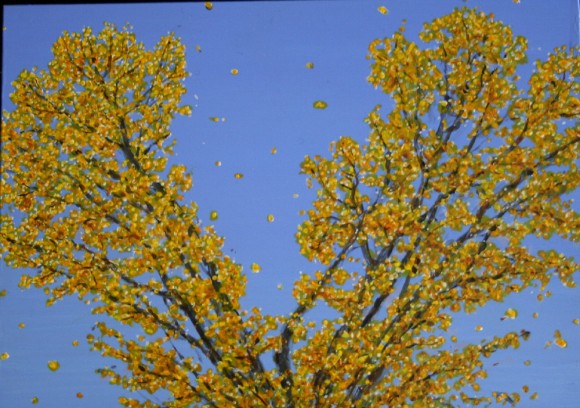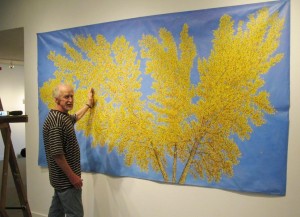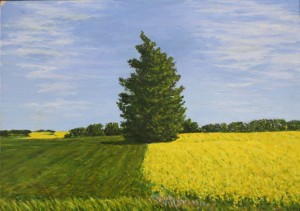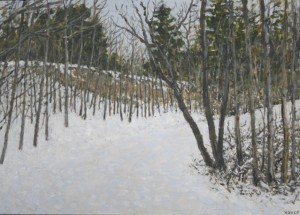ART: Voyer vistas explode with colour
 Mind the stairs as you make your way into the new Sylvain Voyer landscape exhibit opening Saturday at the Douglas Udell Gallery. A huge poplar tree blazes yellow against a deep blue fall Alberta sky, pretty much spanning the big feature wall ― and here’s betting more than one visitor stumbles up the steps as the painting grabs their eye.
Mind the stairs as you make your way into the new Sylvain Voyer landscape exhibit opening Saturday at the Douglas Udell Gallery. A huge poplar tree blazes yellow against a deep blue fall Alberta sky, pretty much spanning the big feature wall ― and here’s betting more than one visitor stumbles up the steps as the painting grabs their eye.
“It’s the largest plein air (open air) painting I’ve ever done,” says the artist. “I began with a roll of canvas and just continued painting. It was a large tree and the larger poplars seem to keep their foliage until later in the season.”
 The tree stood in the Mill Creek Ravine, and after three on-site sessions where he literally spread the canvas on the ground, Voyer completed the piece in the studio. The outdoor time was used to capture the composition and register the colours and some of the detail. The painting also stands out for him because the tree was blown over not long after in a windstorm. He recalls the time as the fall of 2008 as when he was preparing for a major survey of his work at the Art Gallery of Alberta.
The tree stood in the Mill Creek Ravine, and after three on-site sessions where he literally spread the canvas on the ground, Voyer completed the piece in the studio. The outdoor time was used to capture the composition and register the colours and some of the detail. The painting also stands out for him because the tree was blown over not long after in a windstorm. He recalls the time as the fall of 2008 as when he was preparing for a major survey of his work at the Art Gallery of Alberta.
That milestone show was greatly deserved and the Udell show continues that tradition. Voyer has long been recognized as one of Alberta’s major artists, and his work has become appreciated for a number of reasons.
 Firstly, he has a superb colour sense. Not many landscape painters are willing to tackle Alberta’s big skies and bright colours, but Voyer can do it without creating a cliché. He is most well-known for brilliant yellow canola fields stretching under banner blue skies streaked with wispy mares’ tails of cloud.
Firstly, he has a superb colour sense. Not many landscape painters are willing to tackle Alberta’s big skies and bright colours, but Voyer can do it without creating a cliché. He is most well-known for brilliant yellow canola fields stretching under banner blue skies streaked with wispy mares’ tails of cloud.
“I must have painted a couple hundred over 20 years,” he says, “but they still have punch. I go out in July and they’re electric ― the blue sky and the yellow fields.”
Voyer is not only a superb draughtsman, but he’s also a student of the land. He takes your eye and leads it across early spring fields, streaked with dark soil – not necessarily on a bright day, but perhaps on a dreary, fading light, late afternoon.
Much of his work is done on-site, and during the six years he and his wife, Jean Compagnon, lived in Claresholm, he travelled the land corresponding to Latitude 50, before returning to Latitude 53 (Edmonton’s latitude) last year. Thus, the exhibition is entitled “Latitude 50 to Latitude 53.”
“I like to work in a series,” Voyer explains. “It’s about contours, topography. I could be painting one scene and then look across the road and see another beautiful landscape.”
 While living in the South, the painter would drive from Waterton, North along the Cowboy Trail, all the way to Kananaskis. “I find it extremely stimulating to get that vista and sense of place,” he says. “I want people to experience what I went through.”
While living in the South, the painter would drive from Waterton, North along the Cowboy Trail, all the way to Kananaskis. “I find it extremely stimulating to get that vista and sense of place,” he says. “I want people to experience what I went through.”
Now, back in Edmonton, he still drives into the country, but he also packs up a converted tackle box and takes to his bicycle to reach the river valley, Mill Creek and the like. That mobility is important to him, so he often paints small format ― 5” by 7” is his typical size.
If you make it past the stairs in one piece, you’ll be treated to over 80 works, most of which are 5” by 7” inches. The collection is grouped by latitude. The South wall (read the fine print stencilled on the walls) is from the Cowboy Trail area, while the Northern latitude is mounted on the north side of the gallery (again, look for the “Latitude 53”). As well, the locations are roughly grouped together – the vistas derived from the same location.
And although the massive banner work “Untitled” (well, perhaps called “Fall Tree”), is out of character – particularly for this exhibition (at 64” by 118”, it’s almost three times the size of the combined total of the rest of the show) ― the opportunity to view these Alberta vistas through the eyes of this accomplished painter is not to be missed.













